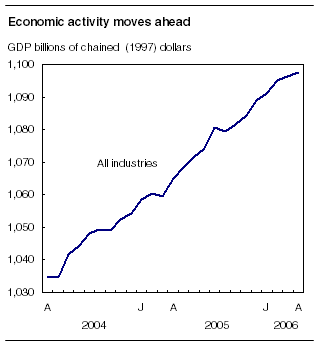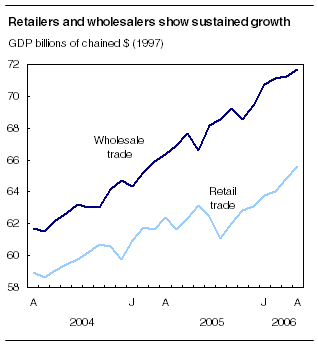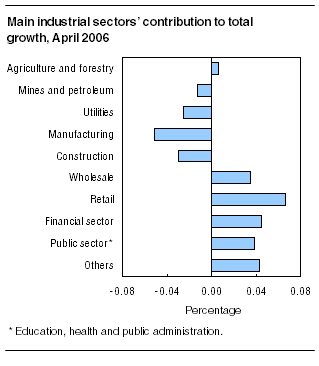
















 |
|
 |                |
Information identified as archived is provided for reference, research or recordkeeping purposes. It is not subject to the Government of Canada Web Standards and has not been altered or updated since it was archived. Please "contact us" to request a format other than those available.

|

Thursday, June 29, 2006 Gross domestic product by industry
The Canadian economy advanced by 0.1% in April, matching the pace of the previous month. Overall, services output rose by 0.3% in April, sustained mainly by growth in retail and wholesale trade, the financial sector, and in transportation and warehousing. In contrast, declines in utilities, construction, manufacturing, as well as in mining, oil and gas exploration resulted in a 0.3% drop in the goods-producing industries. 
Continued growth in retail and wholesale tradeWidespread increases in activity in the retail trade sector led to a 1.2% gain in April. This growth was driven largely by higher used vehicle sales and a rebound among food and beverage retailers and service stations. The largest declines were recorded by building materials stores, and by furniture, home furnishings and electronics stores.
Building on its gains in the previous four months, wholesale trade climbed 0.6% in April. Growth was especially strong among wholesalers of motor vehicles, computers and electronic equipment, and home and personal products. Wholesalers of office and professional equipment recorded the largest decline. Growth in the financial sectorThe financial sector grew by 0.2% in April, partly due to strong mutual fund sales. For a fourth straight month, stockbroker activity showed strong growth (+1.3%). However, mirroring the home resale market, real estate brokers experienced a net decrease of 2.7% in their activity. Air transportation and educational services both risingFor a third straight month, the transportation and warehousing sector advanced in April (+0.6%). This growth was felt in almost all types of transportation services but was strongest in air transportation (+1.9%) where the upward trend has been sustained for the past four months. Educational services advanced 0.4% regaining the ground lost the previous month because of a labour conflict in Ontario colleges. Rebound in motor vehicle production not enough to stop a decline in the manufacturing sectorManufacturing output decreased 0.3% in April in response to a weakening in both non-durable (-0.2%) and durable (-0.4%) goods. Of the 21 major groups, 10 declined, representing 46% of total manufacturing output. Among the non-durable goods-producing groups, the decreases recorded in food, textiles, oil and coal, and plastics and rubber were partially offset by gains in paper manufacturing and chemical products. Durable goods manufacturing receded, mainly due to wood products, fabricated metal products, machinery and furniture. However, a rebound in motor vehicle production (+2.9%) and in aerospace products (+2.9%) helped limit losses in durable goods manufacturing. 
Energy sector declinesAfter a sharp jump in March, oil and gas exploration receded 9.7% in April, spurring a 0.8% decline in the energy sector. The production and transmission of electricity (-1.0%) were also strong contributors to the decrease. Recovery in oil and natural gas extraction (+1.0%) in April, after three straight months of declines, was not enough to offset these losses. The impetus for the recovery in oil extraction was an acceleration of heavy crude production, driven by the first time direct access to US refineries on the coast of the Gulf of Mexico. Beyond the activities related to energy resources, mining extraction (+3.2%) partially regained the losses recorded in previous months. After four months of decreases and despite high inventory levels, the imminence of supply contract renewals spurred potash producers to increase their activity substantially (+19%). Industrial production (that is, the output of factories, mines and utilities) fell 0.4% in April, fuelled by the decrease in utilities, oil and gas exploration, and by the reduction in manufacturing output. In the United States, industrial production advanced 0.8%, driven up by mining, utilities and manufacturing. 
Construction continues to lose groundAfter almost two years of uninterrupted growth, construction recorded its second straight loss in April (-0.5%). Following a net decline in March, residential construction fell again in April (-0.8%). Housing demand slowed in many urban areas. Non-residential construction fell 0.5%, owing to a decline in work on industrial buildings, while construction of commercial and institutional buildings advanced. Available on CANSIM: tables 379-0017 to 379-0022. Definitions, data sources and methods: survey number 1301. The April 2006 issue of Gross Domestic Product by Industry, Vol. 20, no. 4 (15-001-XIE, free) is now available in electronic format from the Our Products and Services page of our website. Prices will continue to be charged for electronic products that require manual intervention by Statistics Canada staff (e.g., CD-ROM, files which have to be mailed, e-mailed or faxed to clients), database services (CANSIM), and other priced datasets which are available on the Internet. Data on gross domestic product by industry for May will be released on July 31. For general information or to order data, contact Yolande Chantigny (1-800-887-IMAD; imad@statcan.gc.ca). To enquire about the concepts, methods or data quality of this release, contact Bernard Lefrançois (613-951-3622), Industry Accounts Division.
| |||||||||||||||||||||||||||||||||||||||||||||||||||||||||||||||||||||||||||||||||||||||||||||||||||||||||||||||||||||||||||||||||||||||||||||||||||||||||||||||||||||||||||||||||||||||||||||||||||||||||||||||||||||||||||||||||||||||||||||||||||||||||||||||||||||||||||||||||||||||||||||||||||||||||||||||||||||||||||
|
|
|